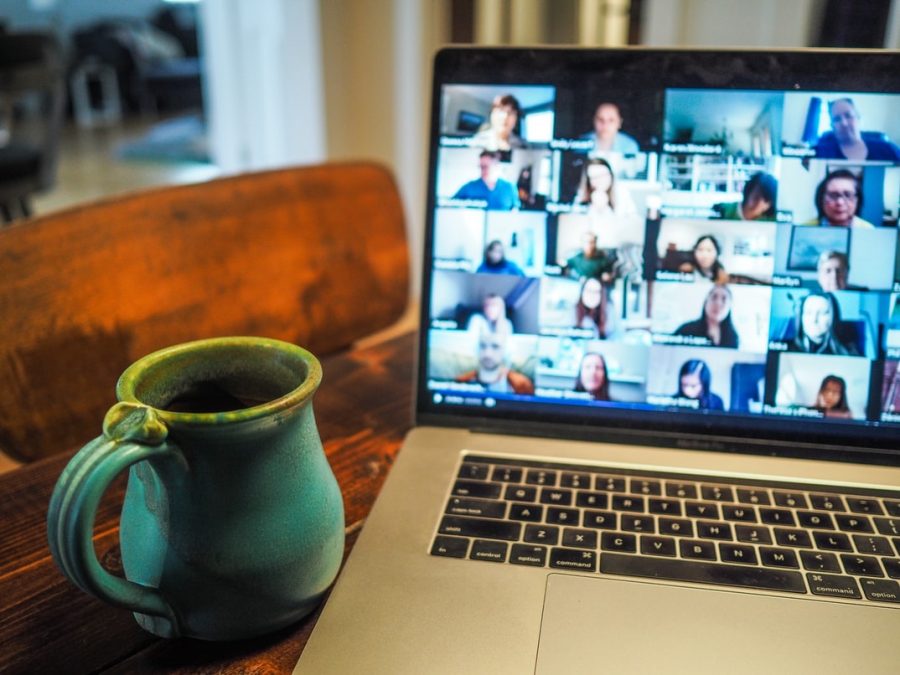Gannon community weighs in on remote learning
October 19, 2021
Gannon University went fully remote in March 2020, and since then students and faculty have had to quickly adjust to the new norms of the COVID-19 pandemic: wearing masks, working remotely and vaccinations. The transition to remote learning was necessary for the function of education, work and life.
Members of the Academic Advising Team, the board of advisers on campus, said they were happy to find that the students were still able to establish and build a solid connection with the students. Team members considered advising by Zoom to be an effective next-best-thing to in-person advising.
Philosophy professor Aaron Kerr believes that students would rather be in class because they learn from each other when questions are asked together and they pick up on nonverbal cues that happen in learning environments. In education there is a lot of interpreting and it difficult to do that in isolation or via Zoom.
Kerr said that students lose that experience while remote but gain the opportunity to “step back and observe.” He feels it’s more direct and transparent. For example, he can ask a student to participate in a discussion through the chat room without putting them on the spot.
At first remote learning was a challenge in teaching but Kerr embraced it. He said that having a mask has made his teaching more serious.
“When in the classroom I sense a lot of students aren’t getting it and this isn’t what they want to be doing,” said Kerr. “So, I start to become a comedian, but I can’t rely on my default personality or facial expressions. That means the material or context has been at the forefront.”
What Kerr has done in his class is create little written discussions or class feedback, which has been helpful for him to make sure his students actually understand. Kerr also expressed concerns with remote learning, like how it individualizes education and separates the learning process from students.
“Many (students) are depressed and instead of engaging in class they stay away and are isolated, when what they need is to have a sense of belonging to a group of people who are learning a common subject or have common aspiration for careers or professional lives,” Kerr said. “Education is about belonging.”
However, Kerr said he does like that remote learning can give students access who otherwise wouldn’t have it and that it can provide students with an outlet for expression, and they can remain anonymous through the chat room and participate while on Zoom.
On that note, Kendall McGarity, is a first-generation college student who had to move back into a house with her parents and siblings who don’t understand what being a full-time student is like. McGarity said her parents expect her to get a job and be the same person she was during the summer, but they don’t understand the stress she has while in school. McGarity said she has developed both anxiety and depression since the pandemic began and academically has had trouble getting back into the grind of school.
“I no longer strive to have all A’s or even B’s,” said McGarity, a senior biology major with a minor in education. “To me, I now only strive to pass my classes.”
McGarity said being a collegiate wrestler and a quarantined student is more difficult than people acknowledge. Her mental health has worsened since coming back to school because she feels like everyone is trying to force the idea that things will go back to normal, when in reality that is impossible.
“With deadlines, exams, assignments, practices and COVID-19 tests, as well as just trying to be a functioning piece of society on campus, I feel like most students are struggling mentally but are still being forced to suppress those feelings just to meet those things,” said McGarity.
McGarity said that the transition to remote learning was hard because the distractions were so overwhelming, and it was impossible to focus while at home with her family. She is currently taking biology courses, but it was very difficult for McGarity because she said that it’s hard to grasp things that are supposed to be taught in a lab setting. Also, she said that learning remotely is a struggle when you have a short attention span.
“I am the kind of person where I need to leave my house in order to complete homework,” said McGarity. “When I’m home I find something more important to be doing than schoolwork. While this is a personal issue rather than a school issue, it is nearly impossible for me to learn if I cannot be surrounded by peers in a non-distracting environment like a classroom.”
In addition to this, McGarity said that it is more difficult to get in touch with her professors because having to talk through emails and ask questions via Zoom takes away the face-to-face interaction and it’s more difficult to explain the content. However, McGarity said that remote learning does give people the opportunity to access school anywhere in the country.
Similar to McGarity’s feelings toward remote learning, Darius Brooks-Alston, a freshman, said that he almost didn’t pass his junior year of high school. Brooks-Alston had to do remote learning and it was hard because he believed his school wasn’t ready to go online. He said that before remote learning they were using Edgenuity, and that site kept crashing and most
of the students failed. During COVID-19 they used a site called Schoology, and it got better. He went back to in-person learning his senior year of high school.
Brooks-Alston, a cyber engineering major, said that the pandemic and remote learning have affected his academics. Specifically, courses like Calculus and English are hard for him to catch up since the pandemic because he “feels dumb,” has increased stress and almost no motivation. He is also taking core classes like Philosophy, Intro to Internet, First Year Seminar and College Composition.
Brooks-Alston doesn’t like learning remotely because he can’t focus while on the computer and information isn’t retainable for him, but he does understand that remote learning is just a different way of interpreting information.
Similar to Brooks-Alston’s opinions on remote learning, Jordan Tolliver, a junior advertising communication and marketing major, said he dislikes it because in a way it doesn’t allow him to be productive and or have a set schedule.
“I didn’t like it at all since you didn’t have to go anywhere,” said Tolliver.
Tolliver said he wasn’t even able to get out of bed and open his computer for class. He felt it was pointless because it was all remote and he couldn’t get the same experience as in the classroom.
The beginning of sophomore year Tolliver lost a lot of motivation because he had three Zoom classes and only two in-person classes. It was hard for him because he said he doesn’t learn that way. Tolliver said he needs to have things put in his face and needs the interaction with his professors. He also said he is a procrastinator and gets to a point where he feels like he can’t get things done in time.
This year, all of Tolliver’s classes are in-person and he is happy to be back in the classroom.
Tolliver began the school year with a good start, unlike Ariana Gonzalez, a sophomore, who started the first week and a half in isolation, but her professors were very understanding about her situation. She doesn’t have any remote classes, but during her freshman year of college she had hybrid classes, which she had no problem with. Gonzalez is a scholar athlete, meaning she has a 4.0 grade point average and was on honor roll her freshman year.
Gonzalez said the transition to remote learning was easy for her because she enjoys online classes. Her classes weren’t affected by COVID-19 last year because she was taking core classes like Theology and Morality, Bible and Algebra. However, Algebra was fully online and that was difficult because she wanted to be in class and ask the professor questions, but she used the tutoring center as a resource for extra help.
However, Gonzalez said she would sleep during Zoom lectures because she didn’t feel like she had to listen because her professors would post the slides on Blackboard and have the recordings up. She also said her attention span got messed up while on Zoom, but she still would like to go back to it because she experiences social anxiety and would rather not be in a classroom surrounded by people.
Gonzalez believes students were rushed into going back to in-person classes after dealing with COVID-19 in the first two years. Since the pandemic began, Gonzalez has also experienced anxiety related to her personal and academic life. She said she wants to be the best and succeed while at Gannon, so her health and grades are her priority.
Like Gonzalez, history professor Alexandra Holbrook said she has dealt with a lot of anxiety during the pandemic. She really missed seeing her family in Ontario, but it made her especially grateful for her husband and daughter.
March 2020 was a surreal time for Holbrook. She said before midterm that semester her classes were learning about the Black Death, the outbreak of bubonic plague in the 14th century. They were reading over a huge variety of behavioral responses and the impacts on culture and the economy. The students noticed the similarities in the early weeks and months of the COVID-19 pandemic.
“More than one student commented on how strange it felt to be living through something that they knew was historically extremely significant,” said Holbrook. “I was very proud of our students for how they adapted to such an unprecedented situation and how they continued to adapt last year for hybrid instruction.”
Holbrook believes that remote learning allows flexibility for students who otherwise can’t make it to class for reasons that meet Gannon’s Zoom guidelines. She also said one of her favorite things about Zoom is the chat feature.
“I had a class last year where the remote students would blow up the chat with side conversations related to things we were talking about in class,” said Holbrook. “I’d pull up the chat to address questions and find people were talking about life on other planets or something. It was distracting but we needed the entertainment sometimes.”
Holbrook did say that remote teaching can be done well but she’d rather be in the classroom with students. Her students have even confided in her about increased anxiety, depression, difficulty focusing and concentrating, unhealthy coping mechanisms and much more. Holbrook understands that it is difficult to learn under those conditions and she has been
sensitive to the emotional impact that the pandemic has had on students and how it affects their ability to learn.
And from this, she realizes the positive out of this issue — the increased attention on mental health.
“We need to take deliberate, thoughtful care of our mental health, and I try to model that for my students and destigmatize talking about it,” said Holbrook.
DESTINY GONZALEZ




